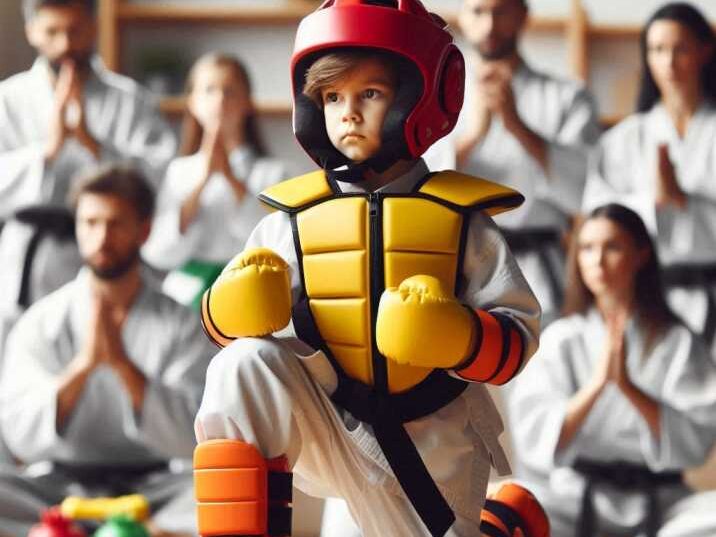1. Introduction
Table of Contents
Is martial arts safe for kids? That’s often the very first question parents ask when considering karate, taekwondo, or judo for their child. It’s a smart question—and the good news is that martial arts safety for children is both achievable and well-practiced when the right steps are taken.
Today, many families choose martial arts because it combines fitness, discipline, and confidence-building. However, like any physical activity, there are risks if kids train without proper supervision or safeguards. Parents naturally want to know how to balance the amazing benefits of martial arts with the potential concerns.
This guide will walk you through everything you need to know: the benefits, possible risks, proven safety practices, and practical tips for keeping your child safe while enjoying martial arts. By the end, you’ll feel confident making an informed decision for your child’s journey.

What Martial Arts Safety Means for Children
When we talk about martial arts safety for children, we’re really asking: How can we make sure kids enjoy the benefits of training without unnecessary risks?
Safety in martial arts doesn’t mean eliminating all challenges. Instead, it’s about creating a supportive learning environment where kids develop skills step by step. Qualified instructors, age-appropriate techniques, and protective gear all play a key role.
In short: martial arts is safe for kids when practiced responsibly, just like soccer, gymnastics, or swimming.
Benefits of Martial Arts for Kids
Parents often focus on safety first—but don’t forget the benefits! Here are some of the biggest advantages kids gain from martial arts:
1. Physical Fitness
Martial arts keeps kids moving in a fun way that doesn’t feel like exercise. Through kicks, punches, and stances, they improve strength, balance, and flexibility. Regular training also helps with healthy weight management and better posture. Unlike screens or sedentary play, martial arts encourages active habits that can last a lifetime.
2. Self-Discipline and Focus
Every martial arts class requires children to listen closely to instructions and follow rules. Over time, they learn to stay focused even when tasks are challenging. Earning belts and mastering techniques teaches them patience and the value of hard work. These lessons carry over into schoolwork, chores, and everyday life.
3. Confidence and Self-Esteem
Kids feel proud when they see their skills improve and move up in belt rank. Even shy children gain courage as they realize what they’re capable of. Martial arts also teaches basic self-defense, which makes kids feel safer and more independent. This boost in confidence often shows up outside the dojo, whether in school, sports, or social settings.
4. Respect and Social Skills
From the first bow, martial arts emphasizes respect—for instructors, classmates, and the practice itself. Kids learn teamwork through paired drills and sparring, building trust and cooperation. Dojo etiquette, like waiting their turn and showing humility, helps children practice manners in real life. These skills prepare them for healthy friendships and stronger communication.
5. Emotional Control
Martial arts gives kids a safe outlet for stress, frustration, and extra energy. Instead of bottling up feelings, they can channel emotions into practice. Instructors also teach calm breathing and composure during sparring, which helps children manage pressure in healthy ways. This ability to stay calm benefits them at school, at home, and in challenging situations outside the dojo.
Possible Risks and Concerns
While martial arts is generally safe, it’s natural for parents to worry about injuries or pressure. Here are the most common concerns:
1. Risk of Injury
Like any physical activity, martial arts can lead to minor bumps, bruises, or sprains. Techniques that involve throwing or kicking, such as in judo or taekwondo, may carry a slightly higher chance of falls or accidental contact. However, these risks are usually small and can be minimized with proper instruction, protective gear, and age-appropriate training.
2. Overtraining or Pressure
Some kids get so excited about martial arts that they want to train every day—but too much practice can cause fatigue or burnout. Competitive programs may also put pressure on children to perform, which can affect their enjoyment. Parents can prevent this by keeping training fun, allowing rest days, and reminding kids that progress is more important than perfection.
3. Inexperienced Instructors
Not all martial arts schools have well-trained or child-focused instructors. An inexperienced teacher may skip safety steps, introduce techniques too quickly, or push children harder than necessary. This can increase the risk of injury or frustration. Choosing a certified instructor who understands children’s needs is key to keeping martial arts safe and positive.
4. Aggression Concerns
Some parents fear that learning martial arts might make kids more aggressive. In reality, well-run programs teach self-control, respect, and non-violence as the foundation of training. Children are reminded that martial arts is not about fighting but about discipline and self-improvement. With the right guidance, kids usually become calmer and more respectful, not aggressive.
Safety Tips and Best Practices
Parents can greatly increase martial arts safety for children by following these proven tips:
1. Choose the Right School
The first step in keeping kids safe is picking a reputable martial arts school. Look for certified instructors who specialize in teaching children and know how to adjust techniques for younger students. Before enrolling, visit the dojo, observe a class, and see how instructors handle discipline, corrections, and safety. A well-structured program creates the foundation for safe training.
2. Start with Age-Appropriate Styles
Not all martial arts are the same, and some are better suited for beginners. Karate and taekwondo focus on basics, structure, and discipline, making them great entry points for kids. More contact-heavy styles, like judo or Brazilian jiu-jitsu, may be better once children are older and more physically prepared. Starting simple ensures safety and builds confidence.
3. Use Protective Gear
Protective gear is one of the easiest ways to prevent injuries during martial arts. Kids should wear helmets, gloves, shin guards, and mouthguards when sparring. Even uniforms, like a gi or dobok, must fit properly to prevent tripping or restricted movement. Parents should check that gear is in good condition and used every time sparring is part of class.
4. Warm-Up and Stretching
Skipping warm-ups can increase the risk of muscle pulls or strains. A good class always begins with light exercises, stretching, and mobility drills to prepare the body. Warming up not only prevents injuries but also helps children focus and get into the right mindset for training. Encourage your child to stretch at home too for extra flexibility.
5. Monitor Training Frequency
Balance is key to safe training. Most children do well with two to three sessions per week, which allows progress without overworking the body. Rest days are just as important as practice days because they give muscles and joints time to recover. Overtraining can lead to burnout or injuries, so parents should keep an eye on their child’s energy levels.
6. Encourage Communication
Teaching kids to speak up if something feels wrong is an important safety step. Children should feel comfortable telling an instructor if they are hurt, scared, or confused about a move. A good teacher will always adjust and make sure the child feels supported. Open communication between parents, kids, and instructors creates the safest environment possible.
Parent’s Role in Safety
Proper Nutrition and Hydration
Kids need the right fuel to stay safe and strong during training. A balanced diet with fruits, vegetables, protein, and whole grains helps them perform better and recover faster. Hydration is just as important—make sure your child drinks water before, during, and after class to avoid fatigue or dizziness. Good nutrition supports both safety and progress in martial arts.
Making Sure Kids Get Enough Sleep
Rest is one of the most overlooked parts of safety. Children who don’t get enough sleep are more likely to lose focus, make mistakes, or get injured. Aim for at least 9–11 hours of sleep depending on your child’s age. A well-rested child will train with better attention, energy, and coordination.
Encouragement Without Pressure
Parents play a big role in keeping martial arts enjoyable. Encourage your child’s progress without comparing them to others or demanding perfection. Celebrate small wins like learning a new stance or earning a stripe on their belt. When kids feel supported instead of pressured, they are more confident and motivated to keep training safely.
How to Practice Safely at Home
If your child wants to practice outside of class, set up a safe space at home. Clear away furniture, use mats for cushioning, and avoid hard surfaces to prevent injuries. Encourage them to review basic moves slowly instead of attempting flips or advanced techniques. Home practice should be about reinforcing skills, not taking risks.
Safety During Tournaments or Competitions
Competitions can be exciting but also more intense than regular practice. Make sure your child wears all required protective gear and follows the rules closely. Remind them that winning is not as important as having fun and staying safe. Good coaches focus on safety first, even in competitive settings.

Real-Life Examples or Stories
Emily, Age 7 – Building Confidence
Emily was shy and often avoided group activities. After joining karate, she learned how to speak up in class and earned her first yellow belt within a few months. Her parents noticed she became more confident at school and was less afraid of making mistakes. Martial arts gave her both courage and self-control.
Daniel, Age 10 – Learning Discipline
Daniel struggled with focus and often got distracted during homework. His parents enrolled him in taekwondo, where he practiced routines and followed step-by-step instructions. Within six months, his teachers noticed he was paying more attention in class. Martial arts gave Daniel a structured outlet that improved both behavior and safety habits.
The Best Starting Age for Martial Arts and Why
Most experts recommend starting martial arts between ages 5 and 7. At this age, children have enough coordination, attention span, and listening skills to follow instructions. Younger kids can join playful introductory programs, but structured martial arts may be too challenging. Starting at the right age sets kids up for safe learning and long-term success.
Comparison Table: Benefits vs. Risks
| Benefits | Possible Risks |
|---|---|
| Builds fitness and strength | Minor bruises or sprains |
| Improves focus and discipline | Pressure from competition |
| Boosts confidence and self-esteem | Inexperienced instruction risks |
| Teaches respect and teamwork | Overtraining fatigue |
| Provides safe self-defense skills | Occasional falls or bumps |
Conclusion
When parents ask, “Is martial arts safe for kids?” the answer is: Yes—when done right. With the proper instructors, gear, and a balanced schedule, martial arts is one of the safest and most rewarding activities your child can join.
It’s not just about kicks and punches. Martial arts teaches children discipline, respect, and resilience—skills they’ll use for life. As a parent, you can feel confident knowing you’ve taken steps to ensure martial arts safety for children while unlocking incredible benefits.
Encourage your child, support their progress, and celebrate every belt they earn. The journey is just as important as the destination.
FAQs
1. Is martial arts safe for young children (ages 4–6)?
Yes, as long as classes are age-appropriate, focus on basics, and keep sessions playful rather than intense.
2. Can martial arts help prevent bullying?
Absolutely. Martial arts builds confidence, which reduces the likelihood of being a target, and teaches non-violent conflict resolution.
3. What martial art is safest for kids?
Karate and taekwondo are generally considered safe for beginners because they focus on form, discipline, and controlled practice.
4. Do kids need protective gear for martial arts?
Yes. Helmets, gloves, and mouthguards protect children during sparring and keep training safe.
5. How many times a week should kids practice martial arts?
Two to three times a week is ideal for most children. This balances progress with rest and prevents burnout.


